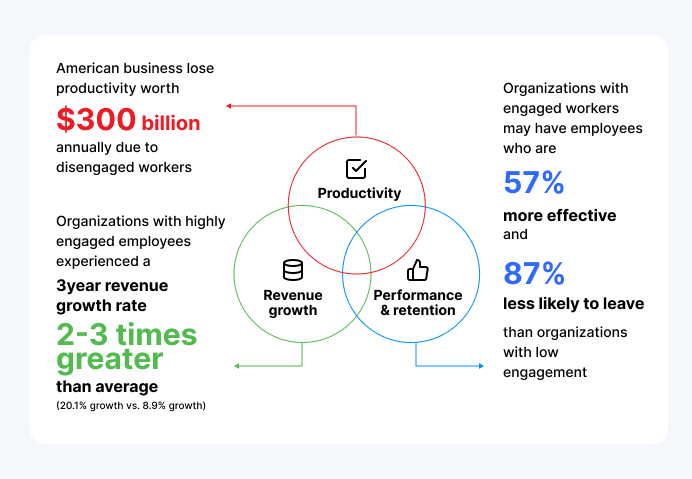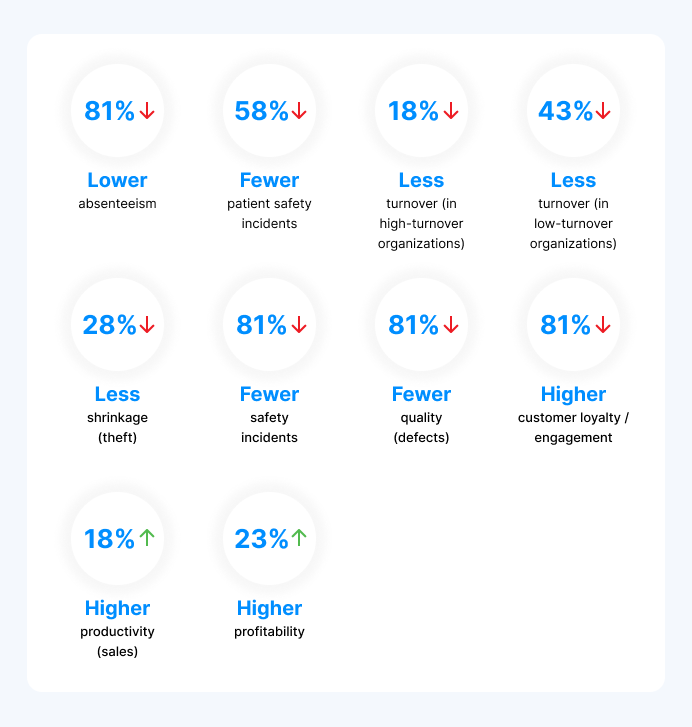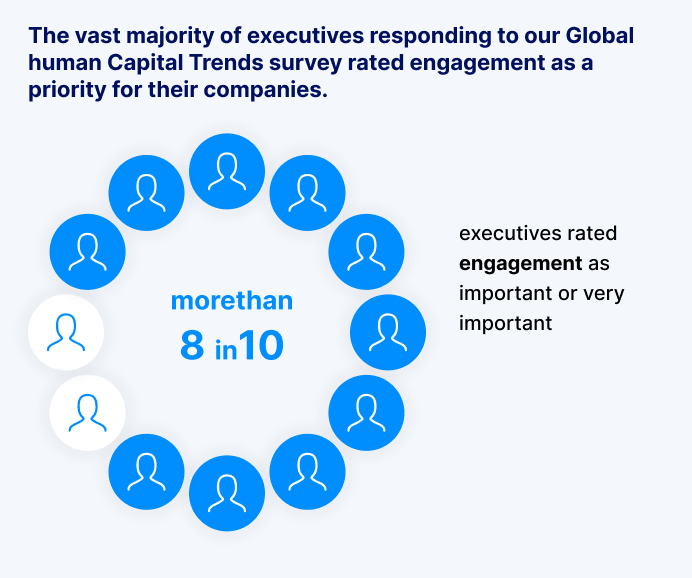I 10 pilastri del coinvolgimento dei dipendenti nel 2025
Il coinvolgimento dei dipendenti consiste nel capire, motivare e mettere in contatto le persone. Ecco i 10 pilastri del coinvolgimento dei dipendenti per una forza lavoro più felice, a più alto potenziale e più produttiva.
In questa pagina
Il coinvolgimento dei dipendenti definisce l'impegno emotivo e la responsabilità di un dipendente nei confronti del proprio lavoro e del datore di lavoro. A Gallup ha concluso che il 23% dei dipendenti si sente impegnato sul lavoro. Nonostante le tendenze, Gallup ha anche evidenziato la necessità di rafforzare i pilastri del coinvolgimento dei dipendenti, in quanto l'evidenza empirica suggerisce che livelli più elevati di coinvolgimento hanno un profondo impatto sul successo di un'organizzazione.
È quindi deludente che solo il 15% dei dipendenti a livello globale (e solo il 35% negli Stati Uniti) si consideri impegnato.
Secondo un rapporto di Deloitte, l'impegno dei dipendenti influisce su diverse aree: produttività, ricavi, prestazioni e persino fidelizzazione dei dipendenti.

Pertanto, le aziende devono migliorare il coinvolgimento dei dipendenti per ottimizzare l'enorme potenziale latente di una forza lavoro più impegnata.
Il management deve concentrarsi sulla comprensione delle cause dell'impegno dei dipendenti e cercare di eliminare le barriere che impediscono un migliore allineamento tra dipendenti e azienda.
I 10 pilastri più importanti del coinvolgimento dei dipendenti
Alcune considerazioni per una migliore abilitazione dei dipendenti sono:
1. Comunicazione
La comunicazione è al centro di qualsiasi sforzo per migliorare il coinvolgimento e creare una cultura aziendale positiva. Essa genera fiducia, trasparenza e migliora il morale dei lavoratori. Una comunicazione efficace richiede la calibrazione di piani per rispondere ai feedback dei dipendenti.
Dare per scontato che i dipendenti abbiano tutto ciò di cui hanno bisogno per svolgere un buon lavoro può essere un difetto fatale. E non riconoscere le esigenze o gli impedimenti dei dipendenti può trasformarsi in problemi più caustici, come il morale basso.
Oggi, comunicare significa anche incorporare vari strumenti tecnologici e creare spazi sicuri per conversazioni sincere e non minacciose. Il lavoro a distanza e ibrido sta creando una nuova enfasi sui modi innovativi per migliorare la comunicazione.
Le aziende farebbero bene a stabilire alcune regole di base per i loro protocolli di comunicazione, per evitare che la comunicazione diventi un'attività perennemente richiesta a tutte le ore del giorno e della notte. Sì, questo significa iniziare a comunicare su come e quando comunicare!
2. Ambiente di lavoro
In un'epoca in cui gli ambienti di lavoro sono oggetto di recensioni online dei dipendenti su siti come Glassdoor, i feedback negativi possono ostacolare la fidelizzazione e l'assunzione dei dipendenti. Gli ambienti tossici sono facilmente identificabili e mettono in evidenza lo scarso coinvolgimento dei dipendenti.
I dipendenti non impegnati non sono entusiasti del loro lavoro e sono molto propensi ad andarsene all'istante. Inoltre, tendono ad avvelenare il pozzo e ad essere molto critici nei confronti di un'azienda che non soddisfa le loro esigenze. La loro influenza negativa si manifesta invariabilmente con scarse prestazioni del team e interazioni negative con i clienti.
3. Collaborazione
Sebbene non sia possibile costringere i dipendenti a diventare amici, è possibile creare più occasioni di interazione casuale per incoraggiare l'instaurarsi di tali legami. I team in cui gli individui vanno d'accordo tra loro tendono a essere più felici e produttivi.
Il nuovo ambiente di lavoro ibrido significa che non è probabile che tutti i dipendenti si trovino nello stesso luogo, come accadeva prima della pandemia. Una collaborazione efficace richiede la scelta degli strumenti digitali giusti per una forza lavoro dispersa.
In questo senso, le aziende tecnologiche hanno svolto un lavoro egregio e hanno avuto un grande successo nel facilitare il futuro del lavoro in circostanze difficili. Esiste una pletora di opzioni. Zoom è ormai un verbo!
4. Premi e incentivi
Premi e incentivi sono una parte essenziale della cassetta degli attrezzi per il coinvolgimento dei dipendenti. Ma molte cose sono cambiate dopo la pandemia. Non sorprende che i dipendenti abbiano una visione diversa delle loro aspettative sul lavoro.
L'era post-pandemia consente alle aziende di ripensare i premi totali e di apportare modifiche ai premi finanziari e non finanziari dei dipendenti per adattarli a questo nuovo ambiente.
Apprezzare i dipendenti, soprattutto quando si spingono oltre, è un potente incentivo a continuare a fare meglio. Dimostra che i dirigenti notano il loro eccellente lavoro e lo premiano.
Anche prima della pandemia, l'American Psychological Association ha stimato che più di 500 miliardi di dollari sono stati persi a causa dello stress sul posto di lavoro. I dipendenti stressati tendono anche ad avere un maggiore assenteismo e un maggiore turnover. E i licenziamenti sono costosi.
Il Center for American Progress stima che la sostituzione di un singolo dipendente costi circa il 20% del suo stipendio.
Lo stress del 2020 ha posto una rinnovata attenzione al benessere dei dipendenti. I programmi di benessere come incentivi per l'abilitazione dei dipendenti hanno sempre fornito un grande ritorno sugli investimenti, ma ora l'86% delle organizzazioni ha un budget dedicato al benessere sul posto di lavoro. Le ricompense stanno cambiando.
5. Sviluppo personale
Nel contesto attuale, la tecnologia consente più opzioni di formazione e riqualificazione che mai. Quando i dipendenti sono felici, impegnati e si sentono sostenuti dalla loro leadership e dal management, tendono a produrre il loro lavoro migliore. Il coinvolgimento riguarda lo sviluppo personale dell'individuo, ma è utile ricordare che lo sviluppo dei dipendenti porta benefici diretti anche all'organizzazione.
Una cultura che incoraggia l'apprendimento continuo crea organizzazioni agili che si muovono alla velocità della concorrenza e del mercato. Non sfruttare queste opzioni di apprendimento per i dipendenti è una pessima scusa per i datori di lavoro e può causare minacce esistenziali all'azienda.
6. Definizione del ruolo
Per avere successo, i dipendenti devono capire e articolare le aspettative della direzione nei loro confronti. Fornire questa chiarezza deve essere una responsabilità del manager. Quando le posizioni non sono chiare, i dipendenti non sanno come il loro lavoro contribuisca al successo, generando confusione e frustrazione.
Nei nuovi modelli per il futuro del lavoro, le definizioni dei ruoli tendono a enfatizzare il prodotto/servizio finale. Le aspettative e persino la delega dei compiti devono essere ridefinite per questa nuova realtà.
Infine, oggi più che mai, la definizione del lavoro e del ruolo deve adattarsi alle aspettative del dipendente nei confronti della propria vita. È fondamentale comprendere le scelte personali dell'individuo e aiutarlo a collegare questi obiettivi con quelli dell'azienda.
7. Sostegno della leadership
Il coinvolgimento dei dipendenti richiede il coinvolgimento e l'investimento del consiglio di amministrazione e del management. I dipendenti devono vedere che la loro C-Suite è coinvolta nel successo delle strategie e dei piani di coinvolgimento. Solo allora si fideranno dello sforzo e si impegneranno nel quadro di coinvolgimento.
I dati di Gallup (vedi sotto) dimostrano che i dipendenti impegnati lavorano in modo più sicuro, più a lungo, producono prodotti e servizi di migliore qualità e portano a una maggiore redditività dell'azienda.

Questo campionario di risultati dovrebbe fugare ogni dubbio sul perché la leadership e la direzione non dovrebbero sostenere e incoraggiare con entusiasmo un migliore coinvolgimento dei dipendenti. Ha un impatto diretto sui risultati!
8. Allineamento con gli obiettivi aziendali
Sempre più spesso i dipendenti non si accontentano solo di uno stipendio. Vogliono trovare un significato e uno scopo in ciò che fanno, anche in un lavoro significativo. Le nuove generazioni che stanno entrando nel mondo del lavoro sono ancora più attente a questo aspetto della loro vita.
Aiutare i dipendenti a capire come il loro lavoro influisca sul quadro generale è un ruolo cruciale dei manager. Le valutazioni delle prestazioni devono concentrarsi sui modi in cui un dipendente può raggiungere meglio gli obiettivi dell'organizzazione.
9. Sondaggi/feedback
Non riuscirete a risolvere i problemi di coinvolgimento dei dipendenti finché non ne avrete determinato il motivo. I sondaggi sono uno strumento utile per determinare quali sono le carenze, dando a tutti la possibilità di fornire un contributo e rassicurando il personale sul fatto che state prendendo sul serio il loro feedback.
L'ascolto è ottimo, ma servono anche i dati. I sondaggi aiutano a raccogliere questi dati. Sul mercato esistono molte opzioni per i sondaggi sui dipendenti. Uno di questi strumenti proviene da Empuls e incorpora sia l'eNPS che le metodologie di coinvolgimento.
È fondamentale definire le varie componenti del coinvolgimento dei dipendenti e poi utilizzare i KPI per valutare il feedback e i progressi. Assicurarsi che i dipendenti esprimano la loro opinione in merito alle risorse, agli strumenti e alla tecnologia di cui dispongono per svolgere bene il proprio lavoro è un feedback essenziale.
La modalità "una volta e basta" non fornisce la modalità di ascolto continuo che fornisce i dati e i risultati migliori.
E ricordate che farete più danni alla cultura aziendale se non farete nulla di ciò che i vostri dipendenti vi dicono. Il feedback deve spronarvi all'azione e non alla "paralisi da analisi".
10. Opportunità di crescita/ tutoraggio
I dipendenti sono alla ricerca di modi per aggiungere valore al loro lavoro e incidere positivamente sulla loro progressione di carriera. I manager devono incoraggiare i dipendenti a raggiungere prestazioni più elevate con tecniche di coaching efficaci e opportunità di formazione per i dipendenti.
In parte ciò dipende dall'incoraggiamento di conversazioni di fiducia in cui i dipendenti non temono le conseguenze di ciò che potrebbero dire.
I manager che hanno conversazioni continue con i dipendenti e chiariscono come il lavoro di un individuo porti al successo dell'organizzazione, probabilmente creeranno dipendenti più entusiasti e impegnati.
È un adagio noto che le persone abbandonano i manager, non il loro lavoro. I manager dovrebbero migliorare la loro capacità di mostrare empatia ai propri dipendenti.
In Give and Take, il Prof. Adam Grant di Wharton dimostra come la gentilezza di un leader possa essere un potente indicatore del successo di un team e permetta ai dipendenti di lavorare a livelli ottimali.
Come Empuls rafforza tutti i 10 pilastri del coinvolgimento dei dipendenti
Creare una cultura in cui i dipendenti siano veramente impegnati non è solo una questione di vantaggi o di stipendio: si tratta di creare connessioni profonde attraverso i pilastri chiave che guidano l'appagamento, la motivazione e lo scopo sul lavoro. È proprio per questo che Empuls di Xoxoday è stato creato.

Empuls è una piattaforma di coinvolgimento dei dipendenti completa e alimentata dall'intelligenza artificiale che consente ai responsabili delle risorse umane e ai manager di rafforzare in modo proattivo ogni pilastro del coinvolgimento con strumenti intelligenti, automazione ed esperienze significative. Non è solo un software: è la spina dorsale di una cultura incentrata sulle persone.
Ecco come Empuls dà vita ai 10 pilastri del coinvolgimento dei dipendenti:
- Leadership: Empuls offre ai leader una piattaforma per essere visibili, trasparenti e stimolanti. Che si tratti di townhalls, shoutouts o AMA (Ask Me Anything), i leader possono connettersi in modo autentico e regolare con ogni livello dell'organizzazione.
- Comunicazione: I team di comunicazione interna possono mantenere tutti allineati e informati attraverso una moderna intranet sociale. Condividete aggiornamenti, celebrate vittorie, fate sondaggi e avviate conversazioni in modo naturale e inclusivo.
- Riconoscimento: Trasformare i momenti quotidiani in festeggiamenti. Empuls consente il riconoscimento peer-to-peer, i premi per le pietre miliari e l'apprezzamento in tempo reale con suggerimenti intelligenti che spingono manager e dipendenti a riconoscere il lavoro eccellente quando si verifica.
- Benessere: Sostenete il benessere olistico con vantaggi curati, accesso anticipato alle retribuzioni maturate, indennità per il benessere e fringe benefit a risparmio fiscale, il tutto da un'unica piattaforma. Perché quando i dipendenti si sentono tutelati, danno il meglio di sé.
- Crescita: Celebrate i traguardi di apprendimento e sviluppo con premi e riconoscimenti personalizzati. Empuls aiuta a rafforzare la cultura della crescita continua con riconoscimenti legati all'aggiornamento, alle certificazioni e ai progressi personali.
- Scopo: Empuls consente di collegare facilmente le iniziative di coinvolgimento ai valori e alla missione dell'azienda. I dipendenti possono riscattare premi per donazioni di beneficenza, partecipare a campagne di CSR e guadagnare badge per vivere i vostri valori.
- Autonomia: Date ai dipendenti la libertà di scegliere come impegnarsi. Dalla selezione dei premi alla personalizzazione delle preferenze di comunicazione, Empuls mette il potere della personalizzazione nelle mani di ogni utente.
- Equilibrio tra lavoro e vita privata: Permettete la flessibilità e l'equilibrio con benefit che supportano il lavoro a distanza, la cura della famiglia, i viaggi e il benessere personale. Empuls vi aiuta a dimostrare ai dipendenti che la loro vita al di fuori del lavoro è altrettanto importante.
- Feedback: Empuls rende l'ascolto dei dipendenti facile e d'impatto. Lanciate sondaggi pulse, eNPS e lifecycle e utilizzate gli analytics integrati per scoprire intuizioni e agire più rapidamente.
- Connessione: Rafforzare le connessioni tra pari attraverso gruppi comunitari, tavole rotonde, celebrazioni ed esperienze condivise. Empuls aiuta i dipendenti a sentirsi parte di qualcosa di più grande, indipendentemente dal luogo in cui lavorano.
👉 Siete pronti a potenziare il vostro personale e ad aumentare il coinvolgimento in tutti i pilastri?
Parlate con un esperto o prenotate una demo oggi stesso.
Chiusura
L'evidenza suggerisce fortemente che una forza lavoro impegnata è fondamentale per il successo di un'organizzazione. In un recente sondaggio Deloitte, i dirigenti hanno espresso chiaramente il loro giudizio sul coinvolgimento dei dipendenti.

Fortunatamente, alcuni dati recenti sul coinvolgimento dei dipendenti sono stati incoraggianti. Gallup riporta che l'impegno dei dipendenti è aumentato del 39% nel gennaio 2021, e anche le generazioni più giovani partecipano a questo aumento.
L'errore più frequente commesso dalle organizzazioni è quello di fare del coinvolgimento dei dipendenti l'unica responsabilità del dipartimento Risorse Umane. Purtroppo, se l'impegno non permea l'intera organizzazione, in particolare tra i manager e i leader, il basso impegno continua a essere un problema persistente con le relative ricadute negative.
Anche se questo dato lascia ancora molte aziende senza che il coinvolgimento dei dipendenti sia una priorità, si tratta di un netto miglioramento.
Man mano che i benefici diventano più evidenti, ci si aspetta che un numero maggiore di aziende abbracci il coinvolgimento dei dipendenti e prenda in considerazione ulteriori strategie per migliorarlo.












